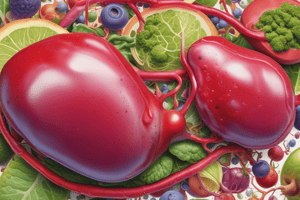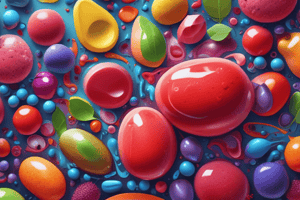Podcast
Questions and Answers
What is the result of a cell placed in a hypertonic solution?
What is the result of a cell placed in a hypertonic solution?
- The cell remains unchanged in size.
- The cell expands due to water intake.
- The cell shrinks due to water leaving. (correct)
- The cell divides into two smaller cells.
Which phase of the bacterial growth curve is characterized by the preparation for growth?
Which phase of the bacterial growth curve is characterized by the preparation for growth?
- Log Phase
- Stationary Phase
- Lag Phase (correct)
- Death Phase
What type of inhibition involves a molecule binding to the allosteric site of an enzyme?
What type of inhibition involves a molecule binding to the allosteric site of an enzyme?
- Feedback Inhibition
- Competitive Inhibition
- Irreversible Inhibition
- Non-Competitive Inhibition (correct)
What is the primary role of ATP in cellular processes?
What is the primary role of ATP in cellular processes?
Which step in aerobic respiration produces the largest amount of ATP?
Which step in aerobic respiration produces the largest amount of ATP?
Which process is NOT involved in binary fission?
Which process is NOT involved in binary fission?
What best describes catabolism in biological systems?
What best describes catabolism in biological systems?
What is produced during anaerobic respiration as a byproduct?
What is produced during anaerobic respiration as a byproduct?
Which process is characterized by the conversion of pyruvate into organic molecules such as lactic acid or ethanol?
Which process is characterized by the conversion of pyruvate into organic molecules such as lactic acid or ethanol?
What is the primary reason flu vaccines need to be updated regularly?
What is the primary reason flu vaccines need to be updated regularly?
What are the two stages of fermentation that occurs in muscles and yeast respectively?
What are the two stages of fermentation that occurs in muscles and yeast respectively?
Which molecule is primarily used as an electron carrier in cellular respiration?
Which molecule is primarily used as an electron carrier in cellular respiration?
How does anaerobic respiration achieve ATP production?
How does anaerobic respiration achieve ATP production?
What describes the concept of herd immunity?
What describes the concept of herd immunity?
Which statement most accurately describes the difference between competitive and non-competitive enzyme inhibitors?
Which statement most accurately describes the difference between competitive and non-competitive enzyme inhibitors?
What is the primary disadvantage of anaerobic respiration compared to aerobic respiration?
What is the primary disadvantage of anaerobic respiration compared to aerobic respiration?
Which of the following nutrients are considered macronutrients essential for cell structure and metabolism?
Which of the following nutrients are considered macronutrients essential for cell structure and metabolism?
What is the primary difference between autotrophs and heterotrophs?
What is the primary difference between autotrophs and heterotrophs?
Which transport mechanism requires energy to move molecules against the concentration gradient?
Which transport mechanism requires energy to move molecules against the concentration gradient?
In which transport process does a cell engulf solid particles as part of its nutrient uptake?
In which transport process does a cell engulf solid particles as part of its nutrient uptake?
Which statement correctly describes osmosis?
Which statement correctly describes osmosis?
What type of solution leads to a cell swelling and possibly bursting?
What type of solution leads to a cell swelling and possibly bursting?
Which of the following best describes facilitated diffusion?
Which of the following best describes facilitated diffusion?
Which micronutrient is essential for enzyme function and is commonly found in cells?
Which micronutrient is essential for enzyme function and is commonly found in cells?
Flashcards are hidden until you start studying
Study Notes
Essential Nutrients for Cells
- Essential Nutrients are required for survival and cannot be synthesized by the cell.
- Macronutrients are needed in large amounts and include carbon, hydrogen, oxygen, nitrogen, phosphorus, and sulfur (CHONPS). They are essential for cell structure and metabolism.
- Micronutrients are required in smaller amounts and often play roles in enzyme function and protein structure. Examples include zinc, iron, and manganese.
Autotrophs vs. Heterotrophs
- Autotrophs can produce their own food using inorganic compounds and energy from sunlight or chemicals. Examples include plants and algae.
- Heterotrophs obtain energy by consuming other organisms. Examples include animals and fungi.
Transport in Cells
- Simple Diffusion is the movement of molecules from high to low concentration without energy or assistance. Oxygen and carbon dioxide moving across membranes are examples.
- Facilitated Diffusion involves carrier proteins and channel proteins to help large or charged molecules cross the membrane without energy. Example: Glucose transport into cells.
- Active Transport requires ATP (adenosine triphosphate) to move molecules against their concentration gradient (low to high). Example: The sodium-potassium pump (Na⁺/K⁺ pump).
- Endocytosis is the process of engulfing material from the external environment by surrounding it with a portion of the cell membrane, which then pinches off to form a vesicle.
- Phagocytosis is "cell eating" for solid particles. For example, immune cells engulfing bacteria.
- Pinocytosis is "cell drinking" for liquids.
- Osmosis is the diffusion of water across a selectively permeable membrane from a region of lower solute concentration to a region of higher solute concentration.
- Tonicity describes the effect of solute concentration on cell shape and water movement.
- Isotonic: Solute concentration is equal inside and outside the cell. Water moves in and out equally.
- Hypotonic: Lower solute concentration outside the cell. Water moves into the cell, possibly causing it to swell and burst (lysis).
- Hypertonic: Higher solute concentration outside the cell. Water moves out of the cell causing it to shrink (crenation).
Binary Fission and Bacterial Growth
- Binary Fission is an asexual reproduction method where one cell divides into two identical cells.
- The process includes DNA replication, elongation of the cell, and division into two daughter cells.
- Bacterial Growth Curve describes the phases of bacterial growth:
- Lag Phase: Bacteria are adjusting to their environment and preparing for growth.
- Log (Exponential) Phase: Bacteria divide rapidly and the population increases exponentially.
- Stationary Phase: Nutrients deplete, and waste products accumulate. Growth rate slows.
- Death Phase: Cells die faster than they reproduce due to a lack of nutrients and accumulation of toxins.
Metabolism
- Metabolism refers to all the chemical reactions occurring within a cell to sustain life.
- Anabolism is the building of large molecules from smaller ones. This process requires energy.
- Catabolism is the breakdown of large molecules into smaller ones. This process releases energy.
Enzymes
- Enzymes are biological catalysts that speed up reactions by lowering activation energy.
- Active Site is the region of the enzyme where the substrate binds.
- Substrate is the molecule that the enzyme acts upon.
- Products are the result of the enzyme-mediated reaction.
- Enzyme Inhibition:
- Competitive Inhibition: A molecule similar to the substrate competes for the active site, blocking the substrate.
- Non-Competitive Inhibition: A molecule binds to a different part of the enzyme (allosteric site), changing its shape and preventing the substrate from binding to the active site.
Energy Production
- ATP (Adenosine Triphosphate) is the energy currency of the cell, composed of adenine, ribose, and three phosphate groups.
- When ATP is broken down into ADP (adenosine diphosphate) and a phosphate group, energy is released for cellular work.
Types of Catabolism
- Aerobic Respiration uses oxygen as the final electron acceptor in the electron transport chain. It produces a large amount of ATP (36-38 ATP per glucose molecule). Byproducts: Carbon dioxide (CO₂) and water (H₂O). Steps: Glycolysis → Krebs Cycle → Electron Transport Chain (ETC).
- Anaerobic Respiration does not use oxygen; other inorganic molecules (e.g., nitrate, sulfate) are used as final electron acceptors. Produces less ATP than aerobic respiration (2-36 ATP per glucose molecule). Byproducts vary depending on the electron acceptor.
- Fermentation does not require oxygen. Only glycolysis is used, resulting in 2 ATP per glucose molecule. Pyruvate is converted into organic molecules like lactic acid or ethanol to regenerate NAD⁺ for glycolysis to continue. Examples: Lactic acid fermentation (in muscles) and alcohol fermentation (in yeast).
Flu Virus and Immunity
- Flu Virus (Influenza) is a contagious virus affecting the respiratory system. It evolves rapidly, requiring frequent flu vaccine updates.
- Flu Vaccine is a preventive shot that helps the immune system recognize and fight the flu virus if exposed.
- Herd Immunity occurs when a large portion of the population is immune to a disease (through vaccination or previous illness). This reduces the spread of the virus and protects those who are not immune.
Key Vocabulary and Concepts
- Oxidation-Reduction (Redox) Reactions: Chemical reactions involving the transfer of electrons from one molecule to another. Oxidation is the loss of electrons, and reduction is the gain of electrons.
- Electron Carriers transport electrons during cellular respiration. Molecules like NAD⁺ and FAD are reduced to NADH and FADH₂ and then donate electrons to the ETC to produce ATP.
Potential Exam Questions
- Explain the difference between facilitated diffusion and active transport?
- What are the stages of aerobic respiration, and where do they occur?
- How do competitive and non-competitive enzyme inhibitors differ?
- Why does anaerobic respiration produce less ATP than aerobic respiration?
- How do bacterial cells divide, and what are the four phases of bacterial growth?
Studying That Suits You
Use AI to generate personalized quizzes and flashcards to suit your learning preferences.




